| Author |
Topic: Pictures Wanted ! |
Gary Rue
From:
Maryland, USA
|
 Posted 24 Mar 2017 4:12 am
Posted 24 Mar 2017 4:12 am |
|
I'm interested in seeing pictures from forum members who have disassembled a Fender Dbl. neck trapezoid model. I'm curious about the joining of the necks and construction methods. I'm always amazed from the information that pops up on the forum and the previous jobs forum members have shared with me.
I would also like to find a trashed trapezoid pickup to design the top and bottom magnetic covers, or just the covers.
Thanks, Gary. |
|
|
 |
Mike Neer
From:
NJ
|
 Posted 24 Mar 2017 7:47 am
Posted 24 Mar 2017 7:47 am |
|
In terms of the body, it is one solid piece of wood.
_________________
Links to streaming music, websites, YouTube: Links |
|
|
 |
Erv Niehaus
From:
Litchfield, MN, USA
|
 Posted 24 Mar 2017 8:00 am
Posted 24 Mar 2017 8:00 am |
|
Mike is right.
The Stringmasters were held together with two bolts. |
|
|
 |
Harry McIlwain
From:
Mississippi, USA
|
 Posted 24 Mar 2017 1:52 pm
Posted 24 Mar 2017 1:52 pm |
|
The dual pro trapezoid I once owned was in three sections held together by two bolts located under the "diamonds". The sections became loose and I took the diamonds off and tightened the nuts.
Harry |
|
|
 |
Jeff Mead
From:
London, England
|
 Posted 24 Mar 2017 3:17 pm
Posted 24 Mar 2017 3:17 pm |
|
I don't agree that they are a single piece of wood.
I've never taken one of the Dual Pro/Trapezoid models apart but have seen a few (including mine) with cracks in them exactly where you would expect them to be if the body was made of 3 pieces. They are a much tighter, less obvious join than stringmasters but not one piece for sure.

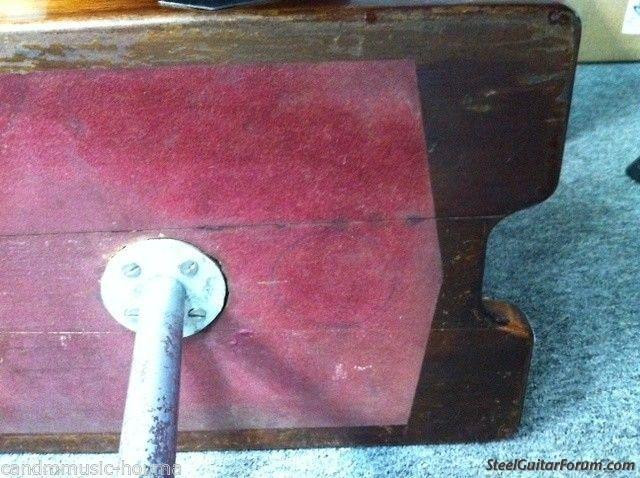
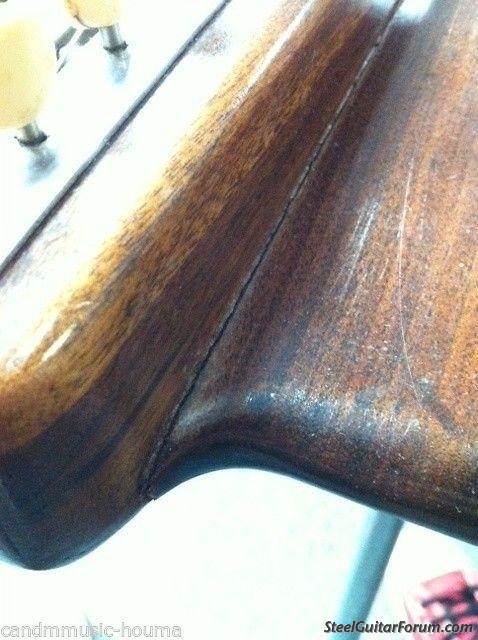
This stripped one is definitely 3 pieces
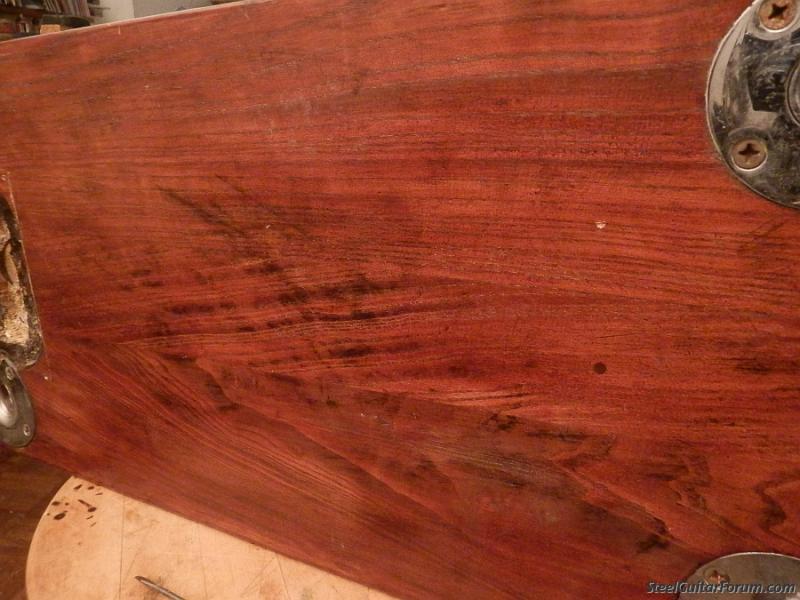
I don't know if they are glued as well as bolted, but they are definitely bolted together:
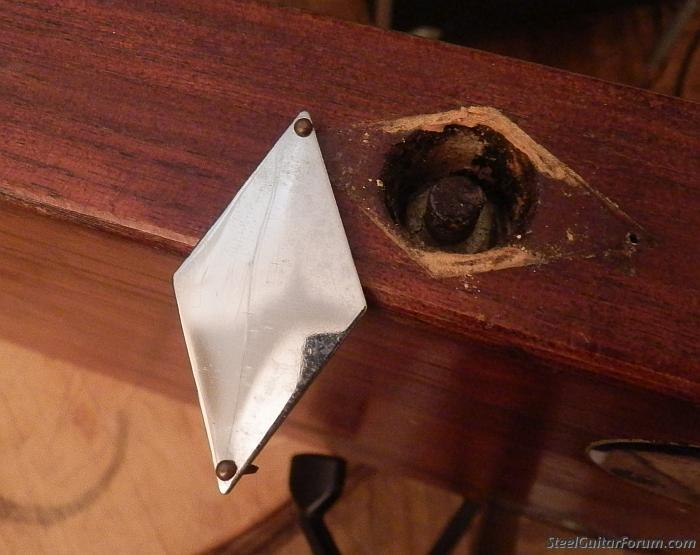 |
|
|
 |
Nathan Laudenbach
From:
Montana
|
 Posted 24 Mar 2017 4:27 pm
Posted 24 Mar 2017 4:27 pm |
|
| Is it possible that some dual professionals were bolted together and some were one solid piece? I have a "53 made of ash and it certainly looks like one piece of wood. |
|
|
 |
Jeff Mead
From:
London, England
|
 Posted 24 Mar 2017 5:10 pm
Posted 24 Mar 2017 5:10 pm |
|
I can't imagine them changing the manufacturing process as dramatically as that after the guitar had been in production for a few years already and while they were just about to launch a new model.
I'm sure some guitars have better grain matches and tighter joins than others. For years I thought my 56 Tele body was a single piece of wood until a friend spotted the join.
Maybe you could post some detailed pictures? |
|
|
 |
Doug Beaumier
From:
Northampton, MA
|
|
|
 |
Gary Rue
From:
Maryland, USA
|
 Posted 24 Mar 2017 6:17 pm Great
Posted 24 Mar 2017 6:17 pm Great |
|
Great photos. I bought one thinking it was in very bad shape but it was just 70 years of dropping the bar on it. The seams on mine are so perfect I thought it had a one peice bottom (1/4) thick with the bolt ons above it. These pictures really help.
Another Question? What years did the plastic volume (V) on the top and plastic tone knobs run? Again, I'm amazed by a 70 year old plastic knob surviving. I beleive I was told the wrong year on my steel unless the plastic knobs came after the metal knobs. |
|
|
 |
John Dahms
From:
Perkasie, Pennsylvania, USA
|
 Posted 24 Mar 2017 6:43 pm
Posted 24 Mar 2017 6:43 pm |
|
I have one of the first Dual Professionals (ca.'47, with no legs) and one of the last in '55. You would be hard pressed to find swamp ash wide enough to make it in 1 piece.
Both are multi-piece. They are so tightly joined that no seam is apparent but grain does show. The '47 at least is not made up of even sized pieces as one might expect (and as I think might be the case on the later one). They may have built up blocks and then cut them as they thought they were best in each case.

_________________
Time flies like an eagle
Fruit flies like a banana. |
|
|
 |
Jeff Mead
From:
London, England
|
 Posted 25 Mar 2017 12:28 am Re: Great
Posted 25 Mar 2017 12:28 am Re: Great |
|
| Gary Rue wrote: |
Another Question? What years did the plastic volume (V) on the top and plastic tone knobs run? |
As far as I know, no Fender steels were ever made with plastic knobs.
Certainly the trapezoid models (Dual Pro and Custom Triple) came with domed Telecaster knobs and the Stringmasters came with whatever style of Tele knob was being used that year.
Because they were Telecaster knobs (and easy to remove), that particular part has become very ripe for "harvesting" (how many vintage Tele knobs on Ebay come from Fender steels?).
Most of the time, they are replaced with modern versions and it's hard to tell if they are original or not without looking very closely. I'd say yours got replaced with Strat knobs.
If you're unsure about the year or originality of your guitar, post some pictures and people here will be able to help. There is certainly more knowledge on this forum about Fender Steels than out there in guitar dealer land (I've even heard some wildly inaccurate information from Gruhns). |
|
|
 |
Former Member
|
 Posted 25 Mar 2017 2:50 am
Posted 25 Mar 2017 2:50 am |
|
Nice pictures, thanks Jeff!
Are all Fender SM's made of ash? Mine is painted the dark brown, and the one in the pics I can't tell.
I dig the Industrial-ness of Leo Fender! |
|
|
 |
Jeff Mead
From:
London, England
|
 Posted 25 Mar 2017 2:58 am
Posted 25 Mar 2017 2:58 am |
|
| Ron Ellison wrote: |
Nice pictures, thanks Jeff!
Are all Fender SM's made of ash? Mine is painted the dark brown, and the one in the pics I can't tell.
I dig the Industrial-ness of Leo Fender! |
The pictures in this thread aren't SMs - they are Dual Pros (the earlier model). |
|
|
 |
Former Member
|
 Posted 25 Mar 2017 3:20 am
Posted 25 Mar 2017 3:20 am |
|
I know that!!--Haha, guess I got a little excited!!
getting ready for the operation..... |
|
|
 |
Doug Beaumier
From:
Northampton, MA
|
 Posted 25 Mar 2017 6:56 am
Posted 25 Mar 2017 6:56 am |
|
Regarding the year of your Fender... there are two ways to approximate that:
Remove the tuner pans and there should be a pencil date written inside the body cavity (month/year), unless the body was refinished at some point. That date is when the body was painted.
Check the source/date code on the pots. That number will tell you when the pots were made. If you find that number post it here. It should be a six digit code and probably starts with 304. Hopefully the pots are original to the guitar.
Some of the early 50s Fender steels and guitars have a little piece of paper inside the cavity with the name of the person who did the final inspection and the date. I've seen several of them that say "Gloria '53" or 52. If you find one of those it's likely that the guitar has never been opened up.
The guitar's features are also helpful in approximating the year. For example, early dual pros, 1940s, have Roman numeral fret markers and boxcar pickups (rectangular). Later ones have trapezoid pickups and bar fret markers. Fender used whatever stock they had on hand, nothing was wasted. So there are a lot of transitional features on the early steel guitars... like an early style pickup or tuner pan on a later model.
_________________
My Site / My YouTube Channel
25 Songs C6 Lap Steel / 25 MORE Songs C6 Lap Steel / 16 Songs, C6, A6, B11 / 60 Popular Melodies E9 Pedal Steel |
|
|
 |
Mike Neer
From:
NJ
|
 Posted 25 Mar 2017 7:07 am
Posted 25 Mar 2017 7:07 am |
|
| Jeff Mead wrote: |
I don't agree that they are a single piece of wood.
|
Looks like you may be right.
_________________
Links to streaming music, websites, YouTube: Links |
|
|
 |
Jeff Mead
From:
London, England
|
 Posted 25 Mar 2017 8:17 am
Posted 25 Mar 2017 8:17 am |
|
| Doug Beaumier wrote: |
| So there are a lot of transitional features on the early steel guitars... like an early style pickup or tuner pan on a later model. |
Even in the Fender catalogue 
 |
|
|
 |
Gary Rue
From:
Maryland, USA
|
 Posted 30 Mar 2017 11:07 pm single peice of wood
Posted 30 Mar 2017 11:07 pm single peice of wood |
|
| I believe there are some one peice dual pro's out there. Very rare. I know another builder who owned one and I believe him. Both of mine are 3 peice. The walnut dual pro has a laminated forward neck that has separated a little above the decal. |
|
|
 |
Jeff Mead
From:
London, England
|
 Posted 31 Mar 2017 2:33 am Re: single peice of wood
Posted 31 Mar 2017 2:33 am Re: single peice of wood |
|
| Gary Rue wrote: |
| I believe there are some one peice dual pro's out there. Very rare. I know another builder who owned one and I believe him. Both of mine are 3 peice. The walnut dual pro has a laminated forward neck that has separated a little above the decal. |
I'd love to see some detailed pictures of one. Are you talking about early prototypes?
I find it hard to believe that they set up a process that worked fine to make these things using 3 separate pieces that were joined together (basically, the way they made everything in the Fender factory) and at some point decided to make a few by carving the whole thing out of a single piece of wood - far more time consuming and labour intensive. The contouring on the part of the body shown in the picture below, for example, would be so much harder to do from a single piece of wood.

There are definitely some out there where the grain is very well matched and the joins are amazingly tight and expertly done and I suspect that is what your friend had. |
|
|
 |
Gary Rue
From:
Maryland, USA
|
 Posted 31 Mar 2017 4:27 am me too
Posted 31 Mar 2017 4:27 am me too |
|
| I respect the talent of the person who told me this but I don't want to use his name. He's built many, many instruments. It's hard for me to believe also. What I see on mine are two horizonally laminated necks and the console center piece. I'm building a proto type with a 1/4 backing plate hidden by a rabbit joint with chambered necks. I'm going to play out with this one for a while and see how she flys. |
|
|
 |
John Dahms
From:
Perkasie, Pennsylvania, USA
|
 Posted 31 Mar 2017 7:35 am
Posted 31 Mar 2017 7:35 am |
|
This is my early Dual Pro. Since it has a non original finish and the flocking is gone off the back it is easier to see the "butcherblock" built up slab of unequal sized pieces it was made from. Even at that there are places where the grain matches pretty well and with a more opaque finish some joints might be invisible.
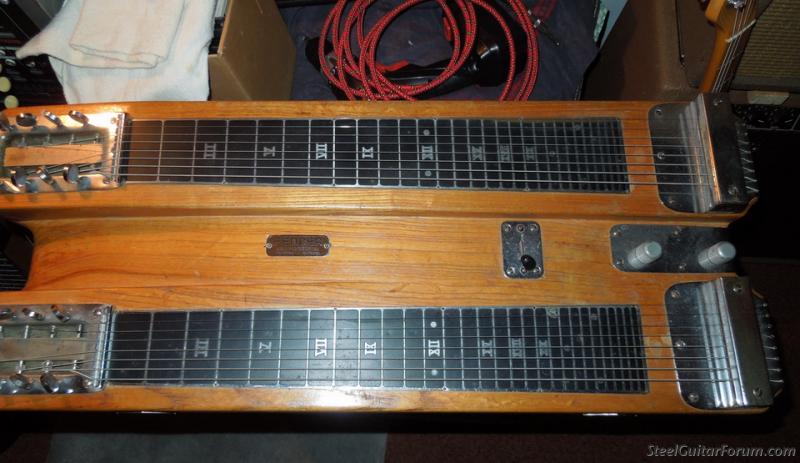


_________________
Time flies like an eagle
Fruit flies like a banana. |
|
|
 |
Doug Beaumier
From:
Northampton, MA
|
|
|
 |
Scott Thomas
|
 Posted 31 Mar 2017 8:38 am
Posted 31 Mar 2017 8:38 am |
|
Unlike Stringmasters which were obviously manufactured as separate necks to be joined later, I wonder if the Duals and Customs were roughed out in pieces, glued together, then shaped and finally bolted through?
You don't see orphaned necks for sale with these guitars as you do with Stringmasters. (At least I haven't.) |
|
|
 |
Gary Rue
From:
Maryland, USA
|
 Posted 31 Mar 2017 9:35 am excellent opinions
Posted 31 Mar 2017 9:35 am excellent opinions |
|
It's hard to tell sometimes whats been repaired. I saw one with dowels instead of bolts with the diamond covers. It's possible a talented wood worker laminated a 1 piece body and did not want the bolts. A good lamination would last a good 50 years.
I also dought Fender wasted any wood. I have a early 70's Japanese fender bass that looks like a butcher block table! |
|
|
 |
Jeff Mead
From:
London, England
|
 Posted 31 Mar 2017 10:26 am
Posted 31 Mar 2017 10:26 am |
|
I think we are talking about two issues here - how many basic pieces are used to make the instrument and whether or not those pieces themselves are made up of more than one piece of wood.
My opinion, until someone shows me evidence to the contrary, is that all Dual Pros are made of 3 basic parts (indicated by the red lines) and each of those parts may be a single piece of wood or itself be made up of 2 or more pieces.
If anyone can show me a Dual Pro made of one piece of wood I'd be fascinated to see it.
 |
|
|
 |




